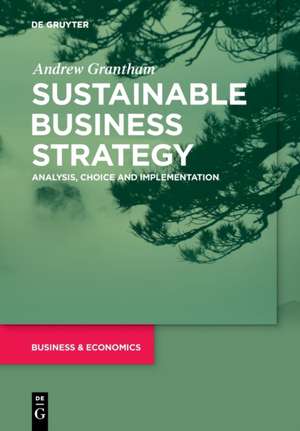Sustainable Business Strategy
Autor Andrew Granthamen Limba Engleză Paperback – 4 apr 2022
Preț: 292.92 lei
Nou
Puncte Express: 439
Preț estimativ în valută:
56.05€ • 58.67$ • 46.65£
56.05€ • 58.67$ • 46.65£
Carte disponibilă
Livrare economică 10-24 martie
Preluare comenzi: 021 569.72.76
Specificații
ISBN-13: 9783110718188
ISBN-10: 3110718189
Pagini: 312
Ilustrații: 13 b/w and 7 col. ill., 45 b/w tbl.
Dimensiuni: 170 x 240 x 20 mm
Greutate: 0.61 kg
Ediția:1. Auflage
Editura: De Gruyter
ISBN-10: 3110718189
Pagini: 312
Ilustrații: 13 b/w and 7 col. ill., 45 b/w tbl.
Dimensiuni: 170 x 240 x 20 mm
Greutate: 0.61 kg
Ediția:1. Auflage
Editura: De Gruyter
Notă biografică
Dr Andrew Grantham is a Senior Lecturer in strategy and Course Leader for UG Business Management at Brighton Business School. Additionally, he has 15 years' experience of leading research at the Centre for Research in Innovation Management at the University of Brighton. His research studies are wide ranging in terms of sectors and firms. He has undertaken micro-level analyses in firms using interventionist methodologies such as investigating change initiatives; implementing continuous improvement; and intellectual property-searching and acquisition. At the macro level studies include scenario building for telecommunications/e-commerce policy makers at the European Commission. Consultancy projects include: investigation into clustering of videogames development companies for South East England Development Agency. His PhD was a comparison of the privatization of the UK rail industry in the 1990s and the industry's rationalization in the 1960s.
He is published in top-rated journals including Research Policy, Public Administration, Technovation and Design Studies.
He is published in top-rated journals including Research Policy, Public Administration, Technovation and Design Studies.
Cuprins
Chapter 1: Introduction to strategy:
Chapter 2: The macro environment
Chapter 5: Business strategy and models - generic strategies, the clock, competitive strategy, co-operative strategies
Chapter 11: Strategy development
- strategy in the context of climate change: science of climate change and models; alternative economic models such as circular economies (zero waste, carbon negative);
- international organizations and regulatory frameworks;
- key figures in strategy and their ideas
- What is strategy?
- how to use the resource.
Chapter 2: The macro environment
- PESTEL (method and utilization);
- Scenarios (how to develop scenarios; investigating plausible futures);
- 5-Forces (Porter, criticisms, using the 5-Forces in the context of climate change);
- Industry life cycles
- Strategic groups
- Resource-based view of the firm (VRIO, contrast with Porter, mitigation, adaptation, VRIO and climate change,
- value chain vis-à-vis supply chains;
- SWOT/TOWS (existing use and methods; emphasizing the T as being the threat of climate change)
- Capabilities (dynamic), competences (core); building new competences necessary for current environment such as sustainability reporting and converting them into strategic resources.
- What is a stakeholder?
- Types of stakeholder
- management of and for stakeholders;
- power (3-dimensions)
- stakeholder utility
- stakeholders and environmental sustainability
Chapter 5: Business strategy and models - generic strategies, the clock, competitive strategy, co-operative strategies
- Generic strategies/strategic clock (cost and price)
- Interactive strategies
- Cooperative strategies (beyond competitive advantage)
- Ansoff matrix (markets, products - new and existing)
- Vertical and horizontal integration
- portfolio management (BCG matrix, GE McKinsey, etc.)
- Yip/drivers of internationalization
- Entry modes
- global value and production networks chains
- international trade
- Rodrik's Trilemma (pure globalization, democratic politics, nation states)
- Collapsing supply chains for sustainability
- models of innovation: product, process and business models
- entrepreneurship, intrapreneurship, real options
- distinctions and cases for one over another
- SAs as voluntary, time-limited, trust related cooperative approaches for sustainable growth
- Strategic fit and cultural fit in partner searching
- Indicators of success (beyond profit)
- Tools of evaluation - performance, gap analysis (beyond profit);
- Addressing key opportunities and threats (TOWS)?
- Financial indicators - DCF, RoI, sensitivity analysis, RoCE.
- Resources and capabilities, opportunity costs
Chapter 11: Strategy development
- Politics (Mintzberg/power school)
- Deliberate and emerging strategy
- structure follows strategy;
- functional, divisional, international, global
- control systems
- optimizing organizational structure
- corporate governance (single vis-à-vis 2-tier boards)
- employee ownership
- Leadership and styles (context, uncertainty, risk, turnaround)
- Types of change - radical/incremental; transformational/realignment
- who to involve, when and how
- planning
- project management
- What is strategy?
- First movers in responsible strategy - risks, rewards
- Fast seconds - risks, rewards
- No changers - risks, rewards
- Society - wellbeing. What is business for?
